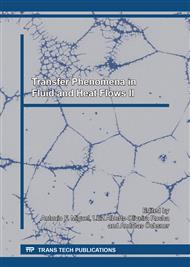[1]
Zukauskas, A. Heat transfer from tubes in crossflow, Advances in Heat Transfer, v. 18, pp.87-159, (1987).
DOI: 10.1016/s0065-2717(08)70118-7
Google Scholar
[2]
Zhang, W.; Samtaney, R. Numerical simulation and global linear stability analysis of low-Re past a heated circular cylinder., International Journal of Heat and Mass Transfer, v. 98, pp.584-595, (2016).
DOI: 10.1016/j.ijheatmasstransfer.2016.03.058
Google Scholar
[3]
Bharti, R. P.; Sivakumar, P.; Chhabra R. P. Forced Convection Heat Transfer from an elliptical cylinder to power-law fluids, International Journal of Heat and Mass Transfer, v. 51, pp.1838-1853, (2008).
DOI: 10.1016/j.ijheatmasstransfer.2007.06.032
Google Scholar
[4]
Thakur, P.; Mittal, S.; Tiwari, N.; Chhabra, R.P. The motion of a rotating circular cylinder in a stream of Bingham plastic fluid, Journal of Non-Newtonian Fluid Mechanics, v. 235, pp.29-46, (2016).
DOI: 10.1016/j.jnnfm.2016.06.013
Google Scholar
[5]
Rao, P.K.; Sasmal, C.; Sahu, A.K.; Chhabra, R.P.; Eswaran, V. Effect of power-law fluid behavior on momentum and heat transfer characteristics of an inclined square cylinder in steady flow regime., International Journal of Heat and Mass Transfer, v. 54, pp.2854-2867, (2011).
DOI: 10.1016/j.ijheatmasstransfer.2011.03.013
Google Scholar
[6]
Nirmalkar, N.; Bose, A.; Chhabra, R.P. Free convection from a heated circular cylinder in Bingham plastic fluids., International Journal of Thermal Science. v. 83, pp.33-44, (2014).
DOI: 10.1016/j.ijthermalsci.2014.04.004
Google Scholar
[7]
Rao, P. K.; Sahu, A. K.; Chhabra, R. P. Flow of newtonian and power-law fluids past an elliptical cylinder, a numerical study., Industrial and Engineering Chemistry Research, v. 49, pp.6649-6661, (2010).
DOI: 10.1021/ie100251w
Google Scholar
[8]
Bejan, A.; Lorente S. Constructal law of design and evaluation: physics, biology, technology and society., Journal of Applied Physics, v. 113, (2013).
DOI: 10.1063/1.4798429
Google Scholar
[9]
Bejan, A. Constructal-theory network of conducting paths for cooling a heat generating volume., International Journal of Heat and Mass Transfer, v. 40, pp.799-816, 1997a.
DOI: 10.1016/0017-9310(96)00175-5
Google Scholar
[10]
Bejan, A. How nature takes shape., Mechanical Engineering, vol. 119, p.90, 1997b.
Google Scholar
[11]
Bejan, A.; Zane J.P. Design in nature,. Doubleday, New York, (2012).
Google Scholar
[12]
Bello-Ochende, T.; Bejan, A. Constructal multi-scale cylinders in cross-flow., International Journal of Heat and Mass Transfer, v. 48, pp.1373-1383, (2005).
DOI: 10.1016/j.ijheatmasstransfer.2004.10.013
Google Scholar
[13]
Bejan, A., Shape and Structure, from Engineering to Nature. Cambridge University Press, Cambridge, (2000).
Google Scholar
[14]
Bejan, A. & Lorente, S., Design with Constructal Theory. Wiley, Hoboken, (2008).
Google Scholar
[15]
Bird R.B., Armstrong R.C., Hassager O. Dynamics of polymeric liquids., Vol. 1: Fluid mechanics. John Wiley and Sons Inc., New York, (1987).
DOI: 10.1002/aic.690340623
Google Scholar
[16]
Slattery, J., C. Advanced Transport Phenomena, Cambridge University Press, New York, (1999).
Google Scholar
[17]
Atapattu, D.D.; Chhabra, R.P.; Uhlherr, P.H.T. Creeping sphere motion in Herschel-Bulkley fluids: flow field and drag, Journal of Non-Newtonian Fluid Mechanics, v. 59, pp.245-265, (1995).
DOI: 10.1016/0377-0257(95)01373-4
Google Scholar
[18]
Silva, J.P. Como calcular a área e o perímetro de uma elipse?, Revista Eletrônica Paulista de Matemática, v. 3, n. 1, pp.2-6, (2014).
DOI: 10.21167/cqdvol3201423169664jps0206
Google Scholar
[19]
Patankar, S. V. Numerical Heat Transfer and Fluid Flow., McGraw-Hill, New York, (1980).
Google Scholar
[20]
Nirmalkar, N.; Chhabra, R. P. Momentum and heat transfer from a heated circular cylinder in Bingham plastic fluids., International Journal of Heat and Mass Transfer, v. 70, pp.564-577, (2014).
DOI: 10.1016/j.ijheatmasstransfer.2013.11.034
Google Scholar


